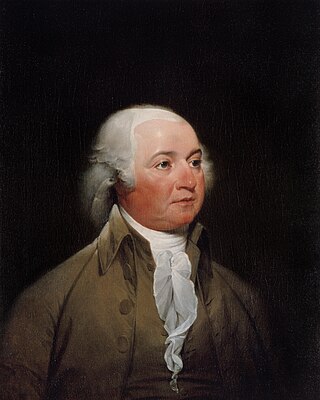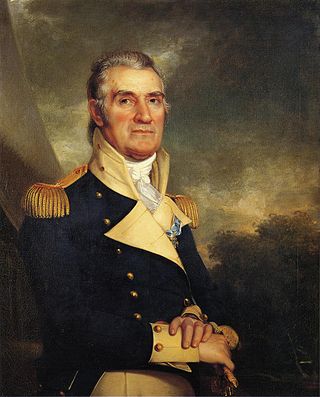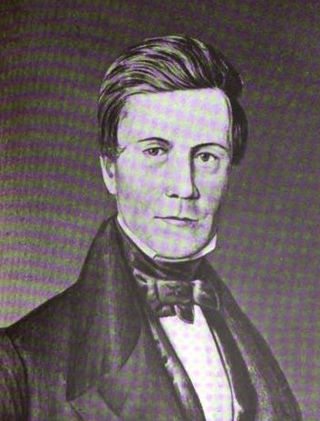Related Research Articles

The 1788–1789 United States presidential election was the first quadrennial presidential election. It was held from Monday, December 15, 1788, to Saturday, January 10, 1789, under the new Constitution ratified that same year. George Washington was unanimously elected for the first of his two terms as president and John Adams became the first vice president. This was the only U.S. presidential election that spanned two calendar years without a contingent election and the first national presidential election in American history.

The 1792 United States presidential election was the second quadrennial presidential election. It was held from Friday, November 2, to Wednesday, December 5, 1792. Incumbent President George Washington was elected to a second term by a unanimous vote in the electoral college, while John Adams was re-elected as vice president. Washington was essentially unopposed, but Adams faced a competitive re-election against Governor George Clinton of New York.

The 1796 United States presidential election was the third quadrennial presidential election of the United States. It was held from Friday, November 4 to Wednesday, December 7, 1796. It was the first contested American presidential election, the first presidential election in which political parties played a dominant role, and the only presidential election in which a president and vice president were elected from opposing tickets. Incumbent Vice President John Adams of the Federalist Party defeated former Secretary of State Thomas Jefferson of the Democratic-Republican Party.

The 1816 United States presidential election was the eighth quadrennial presidential election. It was held from November 1 to December 4, 1816. In the first election following the end of the War of 1812, Democratic-Republican candidate James Monroe defeated Federalist Rufus King. The election was the last in which the Federalist Party fielded a presidential candidate.

The 1820 United States presidential election was the ninth quadrennial presidential election. It was held from Wednesday, November 1, to Wednesday, December 6, 1820. Taking place at the height of the Era of Good Feelings, the election saw incumbent Democratic-Republican President James Monroe win re-election without a major opponent. It was the third and the most recent United States presidential election in which a presidential candidate ran effectively unopposed. As of 2022, this is the most recent presidential election where an incumbent president was re-elected who was neither a Democrat nor a Republican, before the Democratic-Republican party split into separate parties.

The 1832 United States presidential election was the 12th quadrennial presidential election, held from November 2 to December 5, 1832. Incumbent president Andrew Jackson, candidate of the Democratic Party, defeated Henry Clay, candidate of the National Republican Party.

The 2nd United States Congress, consisting of the United States Senate and the United States House of Representatives, met at Congress Hall in Philadelphia, Pennsylvania, from March 4, 1791, to March 4, 1793, during the third and fourth years of George Washington's presidency. The apportionment of seats in the House of Representatives was based on the provisions of Article I, Section 2, Clause 3 of the United States Constitution. Additional House seats were assigned to the two new states of Vermont and Kentucky. Both chambers had a Pro-Administration majority.

Richard Stockton was a lawyer who represented New Jersey in the United States Senate and later served in the United States House of Representatives. He was the first U.S. Attorney for the District of New Jersey, holding that office from 1789 to 1791, and ran unsuccessfully for vice president in the 1820 election as a member of the Federalist Party, which did not nominate a candidate for president.

Samuel Smith was an American Senator and Representative from Maryland, a mayor of Baltimore, Maryland, and a general in the Maryland militia. He was the older brother of cabinet secretary Robert Smith.

In the United States Electoral College, a faithless elector is an elector who does not vote for the candidates for U.S. President and U.S. Vice President for whom the elector had pledged to vote, and instead votes for another person for one or both offices or abstains from voting. As part of United States presidential elections, each state selects the method by which its electors are to be selected, which in modern times has been based on a popular vote in most states, and generally requires its electors to have pledged to vote for the candidates of their party if appointed. A pledged elector is only considered a faithless elector by breaking their pledge; unpledged electors have no pledge to break. The consequences of an elector voting in a way inconsistent with their pledge vary from state to state.

William Grason served as the 25th Governor of the state of Maryland in the United States from 1839 to 1842. Grason also served as a member of the Maryland House of Delegates from 1828 to 1829, and as a member of the Maryland State Senate from 1852 until 1853. He was the first Governor of Maryland directly elected by the general electorate and the first elected governor from the Eastern Shore of Maryland due to a system that rotated the governorship by requiring the governor come from one of three regions in sequence.

The 1912 United States presidential election in California took place on November 5, 1912 as part of the 1912 United States presidential election. State voters chose 13 representatives, or electors, to the Electoral College, who voted for president and vice president.

The 16th New York State Legislature, consisting of the New York State Senate and the New York State Assembly, met from November 6, 1792, to March 12, 1793, during the sixteenth year of George Clinton's governorship, in New York City.

The United States elections of 1788–1789 were the first federal elections in the United States following the ratification of the United States Constitution in 1788. In the elections, George Washington was elected as the first president and the members of the 1st United States Congress were selected.

The 1956 United States presidential election in Maryland took place on November 6, 1956, as part of the 1956 United States presidential election. State voters chose nine representatives, or electors, to the Electoral College, who voted for president and vice president.

The 1792 United States presidential election in Maryland took place on an unknown date in 1792, as part of the 1792 presidential election. Voters chose eight representatives, or electors to the Electoral College, who voted for President and Vice President.

Electoral history of John Adams, who served as the second president of the United States (1797–1801) and the first vice president of the United States (1789–1797). Prior to being president, he had diplomatic experience as the second United States envoy to France (1777–1779), the first United States minister to the Netherlands (1782–1788), and the first United States minister to the United Kingdom (1785–1788). After losing the 1800 presidential election to Thomas Jefferson, he would mostly retire from political life, with his second youngest son, John Quincy Adams (1767–1848), being elected as the sixth President of the United States (1825–1829) in the 1824 presidential election against Tennessee Senator Andrew Jackson.
References
- 1 2 3 "Presidential Electors in Maryland (1789- )". State of Maryland. Retrieved October 23, 2021.
- ↑ The National Cyclopaedia of American Biography. Vol. II. New York, N.Y.: James T. White & Co. 1892. p. 7 – via Google Books.
- ↑ "Bioguide Search".